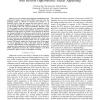Free Online Productivity Tools
i2Speak
i2Symbol
i2OCR
iTex2Img
iWeb2Print
iWeb2Shot
i2Type
iPdf2Split
iPdf2Merge
i2Bopomofo
i2Arabic
i2Style
i2Image
i2PDF
iLatex2Rtf
Sci2ools
WCNC
2010
IEEE
2010
IEEE
ROPA: A MAC Protocol for Underwater Acoustic Networks with Reverse Opportunistic Packet Appending
—In most existing sender-initiated handshaking based underwater Media Access Control (MAC) protocols, only the initiating sender is allowed to transmit data packets to its intended receiver after the channel has been reserved; none of the potentially backlogged neighbors of the sender can transmit in the duration after the current handshake. Therefore, each of those neighbors must initiate their own handshakes, which incur additional overheads and potentially result in poor channel utilization. In this paper, we present a novel approach to increase the channel utilization by allowing a sender to invite its one-hop neighbors (appenders) to opportunistically transmit (append) their data packets. After the sender finishes transmitting its packets to its own receiver, it can immediately switch its role to receive the incoming appended data packets, which arrive in a packet train manner. This greatly reduces the relative proportion of time spent on control signaling. We refer to this MAC...
| Added | 16 Aug 2010 |
| Updated | 16 Aug 2010 |
| Type | Conference |
| Year | 2010 |
| Where | WCNC |
| Authors | Hai-Heng Ng, Wee-Seng Soh, Mehul Motani |
Comments (0)

